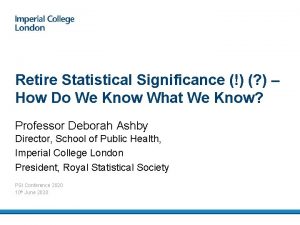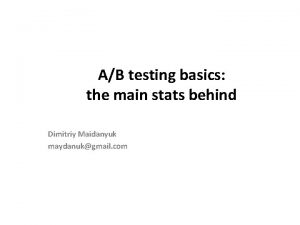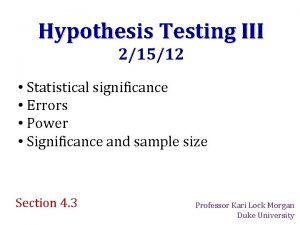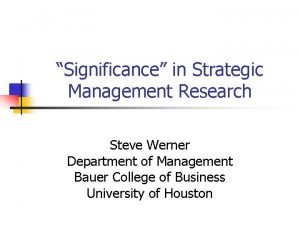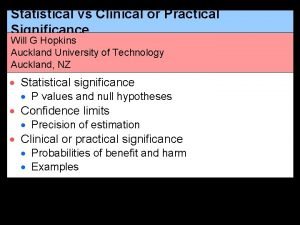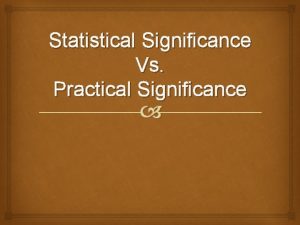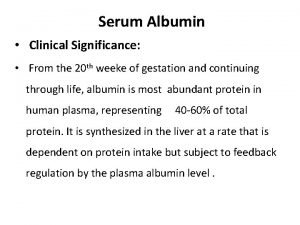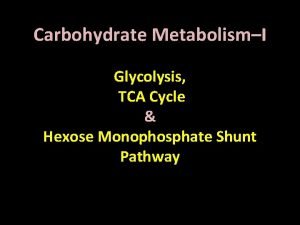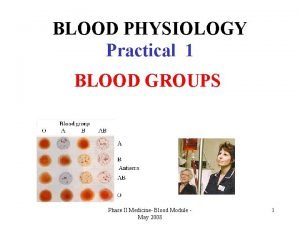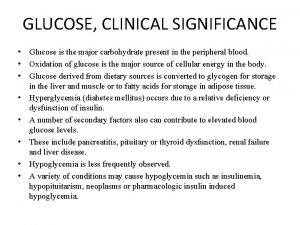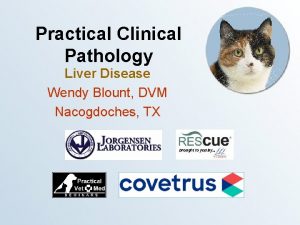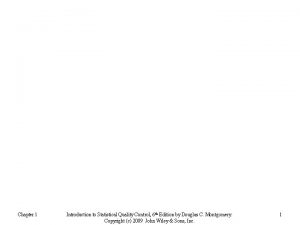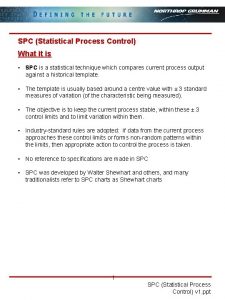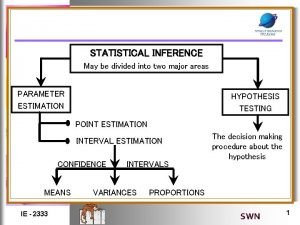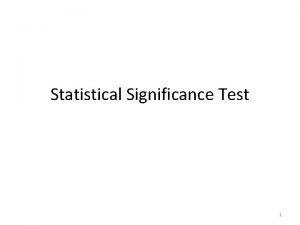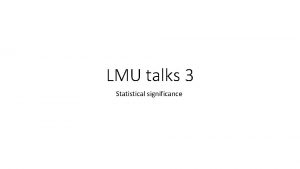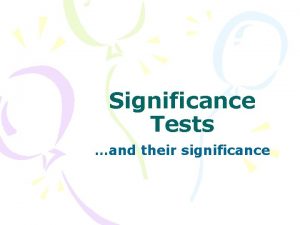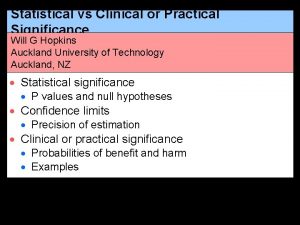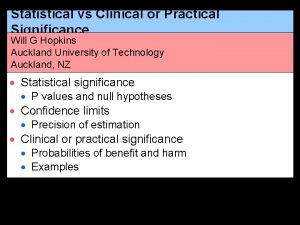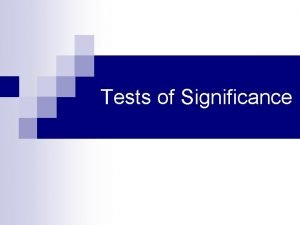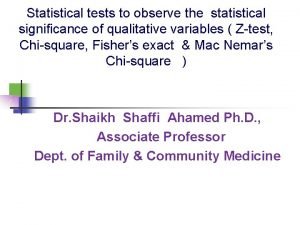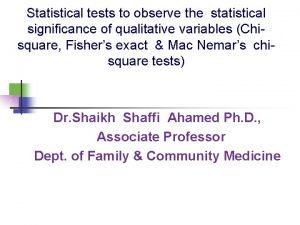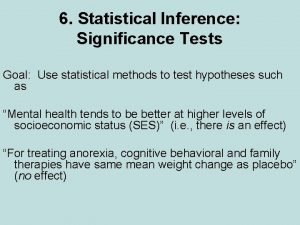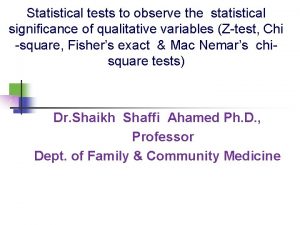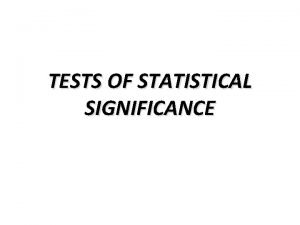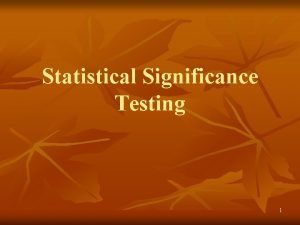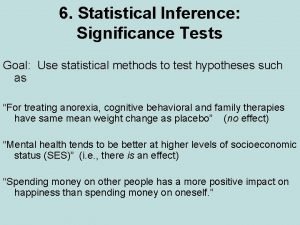Statistical vs Clinical or Practical Significance Will G
















- Slides: 16

Statistical vs Clinical or Practical Significance Will G Hopkins Auckland University of Technology Auckland, NZ · Statistical significance · P values and null hypotheses · Confidence limits · Precision of estimation · Clinical or practical significance · Probabilities of benefit and harm · Examples

Background · Most researchers and students misinterpret statistical significance and non-significance. · Few people know the meaning of the P value that defines statistical significance. · Reviewers and editors reject some papers with statistically non-significant effects that should be published. · Use of confidence limits instead of a P value is only a partial solution to these problems. · What's missing is some way to convey the clinical or practical significance of an effect.

The Research Endeavor · Research is a quest for truth. · There are several research paradigms. · In biomedical and other empirical positivist research… · Truth is probabilistic. · We study a sample to get an observed value of a statistic representing an interesting effect, such as the relationship between physical activity and health or performance. · But we want the true (= population) value of the statistic. · The observed value and the variability in the sample allow us to make an inference about the true value. · Use of the P value and statistical significance is one

Philosophy of Statistical Significance · We can disprove, but not prove, things. · Therefore, we need something to disprove. · Let's assume the true effect is zero: the null hypothesis. · If the value of the observed effect is unlikely under this assumption, we reject (disprove) the null hypothesis. · "Unlikely" is related to (but not equal to) a probability or P value. · P < 0. 05 is regarded as unlikely enough to reject the null hypothesis (i. e. , to conclude the effect is not zero). · We say the effect is statistically significant at the 0. 05

· Problems with this philosophy · We can disprove things only in pure mathematics, not in real life. · Failure to reject the null doesn't mean we have to accept the null. · In any case, true effects in real life are never zero. Never. · Therefore, to assume that effects are zero until disproved is illogical, and sometimes impractical or dangerous. · 0. 05 is arbitrary. · The answer? We need better ways to represent the uncertainties of real life: · Better interpretation of the classical P value · More emphasis on (im)precision of estimation, through

Traditional Interpretation of the P Value · Example: P = 0. 20 for an observed positive value of a statistic · If the true value is zero, there is a probability of 0. 20 of observing a more extreme positive or negative probability value. distribution P value = of observed value 0. 1 + 0. 1 if true value = 0 observed value negative 0 positive value of effect statistic · Problem: huh? (Hard to understand. ) · Problem: everything that's wrong with statistical

Better Interpretation of the P Value · For the same data, there is a probability of 0. 10 (half the P value) that the true value is negative: probability (P value)/2 = 0. 10 probability distribution of true value given the observed value negative 0 positive value of effect statistic · Easier to understand, and avoids statistical significance, but… · Problem: having to halve the P value is awkward, although could use one-tailed P values directly.

Confidence (or Likely) Limits of the True Value · These define a range within which the true value is likely to fall. · "Likely" is probability usually a probability of 0. 95 (defining 95% limits). distribution Area = 0. 95 of true value given the observed value upper likely limit lower likely limit negative 0 positive value of effect statistic · Problem: 0. 95 is arbitrary and gives an impression of imprecision. • 0. 90, 0. 68, or even 0. 50 would be better… · Problem: still have to assess the upper and lower

Clinical Significance · Statistical significance focuses on the null value of the effect. · More important is clinical significance defined by the smallest clinically beneficial and harmful values of smallest clinically the effect. smallest clinically harmful value beneficial value · These values are usually equal and opposite in sign. observed · Example: value negative 0 positive value of effect statistic · We now combine these values with the observed value to make a statement about clinical significance.

· The smallest clinically beneficial and harmful values define probabilities that the true effect could be clinically beneficial, trivial, or harmful (Pbeneficial, smallest clinicall P , P ). · trivial These Ps make an effect harmful beneficial value probability Pbeneficial easier to assess and Ptrivial = 0. 80 (hopefully) to publish. = 0. 15 · Warning: these Ps are smallest clinically Pharmful observ NOT the proportionsharmful of value = 0. 05 ed + ive, non- and - ive value negative 0 positive responders in the population. · The calculations are easy. value of effect statistic · Put the observed value, smallest beneficial/harmful value, and P value into the confidence-limits spreadsheet at newstats. org.

How to Report Clinical Significance of Outcomes · Examples for a minimum worthwhile change of 2. 0 units. · Example 1–clinically beneficial, statistically nonsignificant (see previous slide; inappropriately rejected by editors): · The observed effect of the treatment was 6. 0 units (90% likely limits – 1. 8 to 14 units; P = 0. 20). · The chances that the true effect is practically beneficial/trivial/harmful are 80/15/5%. · Example 2–clinically beneficial, statistically significant (no problem with publishing): · The observed effect of the treatment was 3. 3 units

· Example 3–clinically unclear, statistically nonsignificant (the worst kind of outcome, due to small sample or large error of measurement; usually rejected, but could/should be published to contribute to a future meta-analysis): · The observed effect of the treatment was 2. 7 units (90% likely limits – 5. 9 to 11 units; P = 0. 60). · The chances that the true effect is practically beneficial/trivial/harmful are 55/26/18%. · Example 4–clinically unclear, statistically significant (good publishable study; true effect is on the borderline of beneficial): · The observed effect of the treatment was 1. 9 units

· Example 5–clinically trivial, statistically significant (publishable rare outcome that can arise from a large sample size; usually misinterpreted as a worthwhile effect): · The observed effect of the treatment was 1. 1 units (90% likely limits 0. 4 to 1. 8 units; P = 0. 007). · The chances that the true effect is practically beneficial/trivial/harmful are 1/99/0%. · Example 6–clinically trivial, statistically nonsignificant (publishable, but sometimes not submitted or accepted): · The observed effect of the treatment was 0. 3 units (90% likely limits – 1. 7 to 2. 3 units; P = 0. 80). · The chances that the true effect is practically

Qualitative Interpretation of Probabilities · Need to describe outcomes in plain language. · Therefore need to describe probabilities that the effect is beneficial, trivial, and/or harmful. · Suggested schema: Probability. Chances Odds. The effect… beneficial/trivial/harmfu <0. 01 <1% <1: 99 is not…, is almost certainly not… 0. 01– 0. 05 1– 5% 1: 99– 1: 19 is very unlikely to be… 0. 05– 0. 25 5– 25% 1: 19– 1: 3 is unlikely to be…, is probably no 0. 25– 0. 7525– 75% 1: 3– 3: 1 is possibly (not)…, may (not) be… 0. 75– 0. 9575– 95% 3: 1– 19: 1 is likely to be…, is probably… 0. 95– 0. 9995– 99%19: 1– 99: 1 is very likely to be… >0. 99 >99% >99: 1 is…, is almost certainly…

Summary When you report your research… · Show the observed magnitude of the effect. · Attend to precision of estimation by showing likely limits of the true value. · Show the P value if you must, but do not test a null hypothesis and do not mention statistical significance. · Attend to clinical or practical significance by stating the smallest clinically beneficial and/or harmful value then showing the probabilities that the true effect is beneficial, trivial, and harmful. · Make a qualitative statement about the clinical or practical significance of the effect, using unlikely,

This presentation was downloaded from: A New View of Statistics newstats. org SUMMARIZING DATA GENERALIZING TO A POPULATION Simple & Effect Precision of Statistics Measurement Dimension Reduction Confidence Limits Statistical Models Sample-Size Estimation
 Retire statistical significance
Retire statistical significance Evan miller calculator
Evan miller calculator Statistical significance p value
Statistical significance p value Practical significance
Practical significance Practical significance
Practical significance Practical significance example
Practical significance example Practical significance
Practical significance Albumin clinical significance
Albumin clinical significance Clinical significance of glycolysis
Clinical significance of glycolysis Blood group physiology
Blood group physiology Different methods of glucose estimation
Different methods of glucose estimation Clinical significance of uric acid
Clinical significance of uric acid Clinical significance of glucose
Clinical significance of glucose Normal alt in cats
Normal alt in cats Introduction to statistical quality control
Introduction to statistical quality control Statistical process control ppt
Statistical process control ppt Statistical inference is divided into
Statistical inference is divided into
